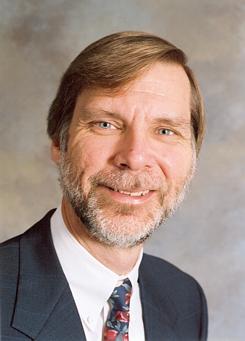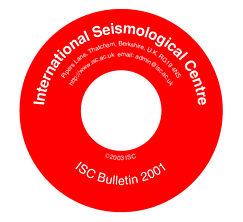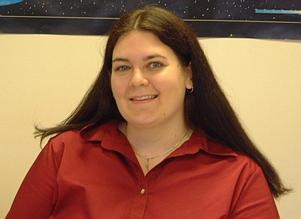Ray Willemann Bids Farewell to the ISC
After six years as Director of the ISC, I am stepping aside at the end of 2003. I would like to take this opportunity to look back on changes to the Centre over that period. When I joined the ISC, the staff and I started a programme to modernise collection, management and distribution of data. Modernisation has changed both how ISC the staff works and how users get data from the Centre.
Creating a web site to distribute data may be the most obvious change, but services have been improved in several distinct ways. One of the most important is the introduction of a "comprehensive" version of the on-line Bulletin, which is based on all of the data that are available to the ISC. In addition to data from the printed Bulletin, which have been individually reviewed by ISC seismologists, the comprehensive version includes three other sets of data: those for events that are too small to warrant manual review at the ISC, those from months that ISC seismologists have not yet manually reviewed, and those that arrived too late for manual review. All of ISC's data are automatically processed to produce a comprehensive Bulletin that is more complete and up to date than the printed version can be.

The ISC's capability to integrate further data at any time allows it to archive and re-distribute data from research projects. As funding agencies and journals place a growing emphasis on making data from research projects more readily available, the ISC has made itself uniquely well-prepared to archive project catalogues of seismic phase measurements and source parameters, and to make the data easily found, even without a priori knowledge data sources.
Seismologists are developing better methods for computing the most fundamental source parameters-the time and location of each earthquake. The ISC joined in this development when Chen Qi-fu of the China Seismological Bureau modified the ISC's location program to use travel times computed from three-dimensional earth models. Together we found that locations computed this way are more accurate, but that higher resolution models will be required to achieve the accuracy now sought by users of ISC data. But even before a new set of travel times has been adopted, this work showed enough benefit from using S arrival times that the ISC began taking advantage of them in routine operations. What's more, the Centre now works with developers of advanced travel time tables to prepare for using them in ISC operations in the future.
Seismologists now use broadband digital data to calculate the progress of earthquake rupture through space and time. As the availability of these data continues to grow, computing the values of distributed source parameters is likely to become routine. The ISC is preparing to provide these types of parameters by developing a system to automatically retrieve waveforms and make its own measurements. A pilot project with the University of Leeds is accelerating the introduction of new measurements and providing the expertise required to establish and monitor operations.
The ISC was founded not to create a complete worldwide earthquake bulletin from raw data, which would be an overwhelming task, but to build on the work of national and regional monitoring agencies to compile a useful global summary. As more stations are installed and an ever-wider range of measurements are made from more capable instruments, the number of data collected by the ISC can continue to grow exponentially.
Automatic processing at the ISC organises the data so that they can be re-distributed in a useful form, and ISC seismologists review those processing results that seem least certain. But the Centre already collects data for several times as many events as can be manually reviewed. Thus, it is important to continue improving results from automatic processing, both by refining the ISC's computer programs and by working with contributors so that ISC's processing can take more complete advantage of regional analyses. In the future, it seems likely that ISC staff will spend progressively more time confirming that data reports have been correctly parsed and processed, reviewing statistical summaries to ensure that the best use is being made of contributed data, and collaborating with colleagues elsewhere to implement and refine automated computation of new parameters and new user services.
Seismologists representing institutional members of the ISC from all around the world serve the on ISC Governing Council. I offer a heartfelt thank you to the many members of the Council who have both supported changes at the ISC, and been patient at the sometimes incremental progress that is difficult to surpass when a small staff must also continue operations. It has been a privilege to serve as director, and to work with the Centre's talented and dedicated staff. I wish the best to all the staff and to the incoming director, Avi Shapira, as they continue developing services to meet the evolving needs of earthquake engineers, seismologists and other earth scientists.
New CDs DistributedThe ISC has distributed its Bulletin CD for earthquakes of 2001 and a new Catalogue CD for earthquakes of 1904-2001. The Catalogue CD is limited to reported and ISC-computed source parameters, such as hypocentres, magnitudes and focal mechanisms. The Bulletin CD includes, in addition, phase data associated with reviewed events, such as onset times and amplitudes. |
|
|
Each CD includes all events for which data were reported. Events that were too small to for review by ISC seismologists are marked with the comment "Event not reviewed at the ISC". As ever, ISC seismologists have reviewed every event for which the ISC provides its own hypocentre or magnitude. |

|
|
Each CD also includes several programs that are useful for analysing ISC data files. One of them is WizMapII, which has a graphical user interface for Microsoft Windows. Another is "iscbul", which is a command-line driven program that is written in Fortran and has been compiled for both Unix and MS-DOS. The new version of iscbul includes fixes to several longstanding bugs. The Catalogue CD includes updated information for earlier years, as well as the most recent year. Updates include additional source parameters for previously reported events, as well as past events for which data were only recently reported to the ISC. The updates include hypocentres computed by Bob Engdahl of the University of Colorado from ISC arrival times using different travel time tables and alternative phase identifications. One of the most important updates to the events of year 2000 is the exclusion of some reported hypocentres with very large uncertainties. The ISC inserts all reported hypocentres in its database, regardless of their uncertainty, since they are useful in internal operations. Distant teleseisms computed from small networks are not intended to be distributed, but were accidentally included in last year's CDs as separate events. All of the data files from the CDs, as well as updated Bulletin files for earlier years, are available from the ISC ftp server, seismo.gvon.ac.uk. Further files are planned be posted to the ftp server as soon as analysis is completed for each month of 2002 and subsequent years. |
|
Station RegistrationThe International Registry of Seismograph Stations facilitates exchange of data between networks by identifying seismic station anywhere in the world with a unique 3 to 5 character code. The Registry is maintained jointly by the ISC and by the World Data Center for Seismology, Denver, which is operated by US National Earthquake Information Center (NEIC). The ISC, NEIC and the European-Mediterranean Seismological Center encourage registration of all stations, regardless of whether or not the data seem likely to be widely distributed. The Federation of Digital Seismograph Networks recognises identification of parametric data with station codes from the International Registry and network code 'IR'. On the ISC web site, the new form at http://www.gxjydl.com/IR/reg.html makes it convenient for network operators to add stations to the Registry. When a station operator submits the registration form, computer programs at the ISC compare the new information with previously registered stations. By immediately prompting users when information is incomplete and by suggesting alternative station codes in real time, the new system reduces the effort required of both station operators and Registry maintainers. When the on-line form is used to register a station, the ISC promptly e-mails a registration record to both the operator and NEIC, and amends the ISC's copy of the Registry. Thus, the new code can be used in parametric data reports to both the ISC and NEIC as soon as the operator receives a registration record. In the Registry, a code is used to identify the site of a seismic station, rather than a particular instrument. Thus the Registry does not deliberately include multiple codes for any site, regardless of how many different seismometers exist or have existed at the site. To maintain this aspect of the Registry's integrity, the on-line system will not register a new station that is very close to a previously registered station. In rare cases when a genuinely new station is very close to a previously registered site, network operators can use the existing system of registering stations by exchanging e-mail with the ISC or the NEIC. Features of the Registry include tracking updates for existing sites, which may be re-surveyed when new instruments are installed. By continuing to use the same code for a site, without regard to what instruments are in use, the Registry makes it straightforward to use the most accurate station locations for older arrival time and ground motion data in re-computing hypocentres and magnitudes. Further development of the on-line system may allow operators to amend a record when a station is closed or re-surveyed. |
|
Maiclaire Bolton joins ISCMaiclaire Bolton of the Geological Survey of Canada has joined the ISC analysis team. Maiclaire works with Dmitry Storchak and Nurcan ?zel editing results from automatic processing for selected earthquakes to produce the "published" version of the Bulletin. |
|
|
Maiclaire recently earned her M.Sc. from the University of Victoria, while working as a research assistant with Gary Rogers at the nearby Pacific Geoscience Centre. Her duties at PGC included locating earthquakes in western Canada using data from the Canadian National Seismograph Network. Her experience in seismology includes finding focal mechanisms and then computing stress orientations, as well as use of advanced methods for computing hypocentres, such as double-difference locations. Maiclaire carried out much of her work at PGC on Unix workstations, so her experience has prepared her for the ISC in several different ways. |

|
|
In her first few weeks Maiclaire has learned ISC editing procedures quickly and has already started contributing to early passes of analysis. |
|